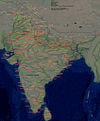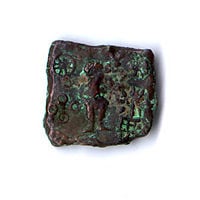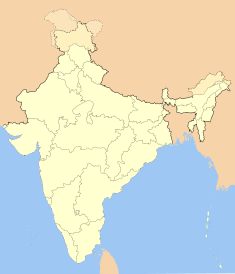Ujjain
| Ujjain Madhya Pradesh • India | |
| Coordinates: | |
| Time zone | IST (UTC+5:30) |
| Area • Elevation |
• 491 m (1,611 ft) |
| District(s) | Ujjain |
| Population | 429,933 (2001) |
Coordinates: Ujjain (Hindi: उज्जैन) pronunciation ▶ (also known as Ujain, Ujjayini, Avanti, Avantikapuri), is an ancient city of Malwa in central India on the eastern bank of the Kshipra River (today part of the state of Madhya Pradesh. It is the administrative centre of Ujjain District and Ujjain Division.
In ancient times the city was called Ujjayini. As per epic Mahabharata Ujjayani was the capital of Avanti Kingdom. It has been the first meridian of longitude for Hindu geographers since the 4th century B.C.E. It is one of the seven sacred cities of the Hindus, and the Kumbh Mela religious festival is held there every twelve years. It is also home to Mahakaleshwar Jyotirlinga, one of the twelve Jyotirlinga shrines to the god Shiva.
History of Ujjain


The earliest references to the city, as Ujjaini, are from the time of the Buddha, when it was the capital of the Avanti Kingdom. Since the 4th century B.C.E. the city has marked the first meridian of longitude in Hindu geography. It is also reputed to have been the residence of Ashoka (who subsequently became the emperor), when he was the viceroy of the western provinces of the Maurya empire.
In the Post-Mauryan period, the city was ruled by the Sungas and the Satavahanas consecutively. It was contested for a period between the Satavahanas and the Ror Sakas (devotees of Shakumbari), known as Western Satraps; however, following the end of the Satavahana dynasty, the city was retained by the Rors from the 2nd to the 12th century CE. Following the enthroning of the Gupta dynasty, the city soon became an important seat in the annals of that empire. Ujjain is considered to be the traditional capital of King Chandragupta II, also known as Vikramaditya, at whose court the nine poets known as the navaratna (nine jewels) of Sanskrit literature are said to have flourished.
In the 6th and 7th centuries, Ujjain was a major centre of mathematical and astronomical research. The famous mathematicians who worked there included: Brahmagupta, whose book Brahmasphutasiddhanta was responsible for spreading the use of zero, negative numbers and the positional number system to Arabia and Cambodia; Varahamihira, who was the first to discover many trigonometric identities; and Bhaskaracharya, or Bhaskara II, whose book Lilavati broke new ground in many areas of mathematics.
Ujjain was invaded by the forces of the Delhi Sultanate led by Iltutmish in 1235, suffering widespread destruction and systematic desecration of temples. Under the Mughal emperor Akbar it became the capital of Malwa.
During the last half of the 18th century Ujjain was the headquarters of the Maratha leader Sindhia. The Scindias later established themselves at Gwalior, and Ujjain remained part of Gwalior state until Indian Independence in 1947. Gwalior state became a princely state of the British Raj after the Maratha defeat in the Third Anglo-Maratha War, and Gwalior, Ujjain, and the neighboring princely states were made a part of the Central India Agency. After Indian independence, the Scindia ruler of Gwalior acceded to the Indian Union, and Ujjain became part of the Madhya Bharat state. In 1956 Madhya Bharat was merged into the Madhya Pradesh state.
Ancient monuments in Ujjain
- Alakhdham nagar - Ujjain is a holy city for Hindus and has many places to visit for the religiously inclined.
- The Mahakal Temple, one of the twelve Jyotirlingas, is the most famous and venerated Shiva temple. The Shivling in this temple is supposed to be the only Jyotirling which faces south and hence it is known as Dakshinmukhi or the south-facing ling.
- Other temples are Harsidhhi (Durga Temple), Chintaman Ganesh, Gadh Kalika, Kaal Bhairav, Sandipani Ashram, Triveni (Nav Graha Shani Mandir), ISKCON (The International Society for Krishna Consciousness) temple [citation needed], Mangalnaath and Siddhhanath.
- Harsidhhi Temple is one of the famous Shaktipeethas all over India.
- Sandipani Ashram is the place where Shri Krishna got education with Balarama and Sudama from Maharshi Sandipani.
- Kaliyadeh Palace - Ujjain, being an ancient city, is home to many monuments that have survived from the ancient period. The most stunning example is the Kaliyadeh Palace on the outskirts of the city, which is a fine piece of ancient Indian architecture, though in poor upkeep.
- The Bhrathari caves is an ancient cave which has some interesting legends associated with it.
- The Observatory (Vedha Shala) built by a Rajput king, Raja Jai Singh II, is one of the five such observatories in India and features ancient astronomical devices.
- The new ISKCON temple is a must for every tourist. Prashanti Dham (Sai Baba's Ashram) is a holy place to visit.
- It is quite a soothing experience to sit on the banks of river Kshipra, relieving all your mental worries. Some places are Ramghat, Narsinghghat, Gangaghat, Gaughat, Retighat, Triveni, Sidhhanath.
- Jain temples like - Jai Singh Pura Atishay Kshetra, Tapobhoomi, Avanti Parshwanath, Hanumant baag etc.
- Kothi Palace presents a sight worth watching in the evening
- A museum named Bharatiya Vidya Bhavan, located near Chamunda tower, where we can see many ancient objects
- It is said that the throne of Maharaja Vikramaditya, known as the seat of judgment (salabanjika throne) can be located in the Rudra Sagar lake
Image gallery
- Mahakal Temple Ujjain.JPG
Mahakal Temple Ujjain
- Kalabhairava Temple Ujjain.JPG
Kalabhairava Temple Ujjain
- Mahakal Jyotirlinga Ujjain.JPG
Mahakal Jyotirlinga Ujjain
- Bhadrakali Ujjain.JPG
Bhadrakali Temple Ujjain
Various Names of Ujjain
Since Ujjain is one of the oldest cities in India, it has been known by very many names, among which were:[1]
- Avantika
- Padmavati
- Kushasthali
- Bhagavati
- Haranyavati
- Kandakatringa
- Kumudvati
- Pratikalpa
- Ujjayani
- Vishala
Geography
Ujjain is situated on the Malwa Plateau in Central India. The soil is black and stony. The vegetation is typical of arid regions with thorny trees like babul and acacia dominating the landscape. Soybean, wheat, jowar and bajra are the main crops grown.
Ujjain is located at .[2] It has an average elevation of 491 metres (1610 ft).
Demographics
As of 2001 India census, Ujjain had a population of 429,933.[3] Males constitute 52% of the population and females 48%. Ujjain has an average literacy rate of 72%, higher than the national average of 59.5%: male literacy is 79%, and female literacy is 66%. In Ujjain, 13% of the population is under 7 years of age.
Climate
Ujjain experiences typical climate conditions of the interior Indian subcontinent. The summer months (April–June) are harsh with temperatures reaching up to 45°C. In addition, hot winds (called loo) may blow in the afternoons, worsening the heat. The winter months (Nov.–Feb.) are pleasant and cool with daytime temperatures typically 20°C, though it may drop to 3°C in the night. The monsoon typically arrives in late June and the months of June till September receive moderate to heavy rainfall. There are periods of rainfall followed by long periods of bright sunshine and high humidity. The month of October generally is very warm and with high humidity.
Administrative
Ujjain city has two legislative assembly zones, known as Ujjain North and Ujjain South. For Parliamentary purposes it is treated as one seat
Economy
The economy of Ujjain is mainly dependent on the agricultural activities of the nearby villages. Two main crops are grown each year: wheat as the major Rabi crop, soyabean as the major Kharif crop. Ujjain agriculture is sensitive to changes in rainfall and failure of monsoon cycles can lay a devastating toll on agriculture and the local economy.
Ujjain was previously a centre of the textile industry with a number of textile mills in and around the city. These mills have since closed, unemploying hundreds. Religious tourism is also a contributor to the economy, especially during the Simhasta Mela.
Commercial Zones
One good thing about the old city is that the market is quite organized. For utensils you have the Patni Bazaar, for jewellery; Sarafa, for grocery; Daulat Ganj, for clothes; VD Cloth Market, Kanthal.
There are various shopping areas like Freeganj, Gopal Mandir, and Satigate.
Freeganj is a rapidly growing area, complete with relatively better modern amenities.
Transport
Ujjain is well-connected by rail and road. It is on the Western Railway and is connected by direct train to most major Indian cities (Mumbai, Delhi, Hyderabad,Chennai, Kolkata, Bangalore, Ahmedabad, Pune, etc).
The nearest airport is Indore, which has daily flights to Delhi, Mumbai, Kolkata,Ahemdabad,Bangalore & Bhopal.
The road network is developed with other parts of Madhya Pradesh. Private buses ply on these roads, though it is best to take your own vehicle for short distances.
An extensive network of old but inexpensive three-wheelers called tempoes serves the majority of the population. Three-wheeler auto-rickshaws are also quite popular. Recent years have seen an explosion of privately owned vehicles, especially two-wheelers unsuited for the traffic, that congest the narrow thoroughfares.
Railway Stations
There are three well-known railway stations:
- Ujjain City Junction
- Vikram Nagar
- Chintaman (metre gauge)
Bus Stations
- Dewas Gate
- NanaKheda
Major Roads
Indore Road, Dewas Road, Agar Road, Badnagar Road, Maksi Road,Ankpat marg,CASE road (in GECU), Mahakal Vainjya Kendra, Panditji Choraha, ISKCON temple,sanver road,
Education
Ujjain city is well known for its university Vikram University which is the main institution of higher education in the city. Besides the university, Ujjain also has different colleges and institutes where students can pursue various courses.
Schools in Ujjain
- St Paul's Higher Secondary School
- Ujjain Public School(UPS)
- Lokmanya Tilak Higher Secondary School[1]
- Kendriya Vidyalaya Ujjain
- Takshshila Junior College
- Christu Jyoti Convent Senior Secondary School
- Kalidas School bambakhana
- Stanford International Girls School
- Gyan Sagar Academy
- The Cambridge H.S.School
- Bhartiya Gyan Peeth Higher Secondary School and College
- Saraswati Vidhya Mandir
- Model Higher Secondary School
- Oxford Junior college(OJC)
- Study Home School (SHS)
- Rohet Children's Academy
- Crown Public School Ujjain
- Gujrati Samaj Higher Secondary School,Nai Sadak
- St. Mary's Convent School
Engineering Colleges in Ujjain
- Government Engineering College, Ujjain (GECU)
- Mahakal Institute of Technology (MIT)
- Mahakal Institute of Technology and Sciences (MITS)
- Mahakal Institute of Technology and Management (MITM)
- Mahakal Institute of Management (MIM)
- Mahakal Institute of Pharmacutical & Sciences(MIPS)
- Alpine Institute of Technology (AIT)
- Prashanti Institute of Technology and Sciences (PITS)
- Guru sandipani Institute of Technology(GSIT)
- Ramotidevi Institute of Technology
Medical Colleges in Ujjain
- Govt. Autonomous Dhanvantri Ayurved College
- R.D.Gardi Medical College ujjain
Management Colleges in Ujjain
- Jawaharlal Nehru Institute of Business Management(JNIBM)
- Mahakal Institute of Management(MIM)
- ICFAI FLP (1st floor sunshine tower)
- Maharaja Institute of information & Technology
- Alpine Institute of Management[4]
See Also
Notes
- ↑ Adrian Room, Placenames of the world: origins and meanings of the names for over 5000 natural features, countries, capitals, territories, cities and historic sites (Jefferson, N.C.: McFarland, 1997) , p. 12.
- ↑ Falling Rain Genomics, Inc - Ujjain
- ↑ Scholastic Library Publishing, Encyclopedia Americana (Danbury Conn: Scholastic Library Pub., 2005), p. 342.
- ↑ Alpine Ujjain
ReferencesISBN links support NWE through referral fees
- Room, Adrian. 1997. Placenames of the world: origins and meanings of the names for over 5000 natural features, countries, capitals, territories, cities and historic sites. Jefferson, N.C.: McFarland. ISBN 9780786401727.
Credits
New World Encyclopedia writers and editors rewrote and completed the Wikipedia article in accordance with New World Encyclopedia standards. This article abides by terms of the Creative Commons CC-by-sa 3.0 License (CC-by-sa), which may be used and disseminated with proper attribution. Credit is due under the terms of this license that can reference both the New World Encyclopedia contributors and the selfless volunteer contributors of the Wikimedia Foundation. To cite this article click here for a list of acceptable citing formats.The history of earlier contributions by wikipedians is accessible to researchers here:
The history of this article since it was imported to New World Encyclopedia:
Note: Some restrictions may apply to use of individual images which are separately licensed.
